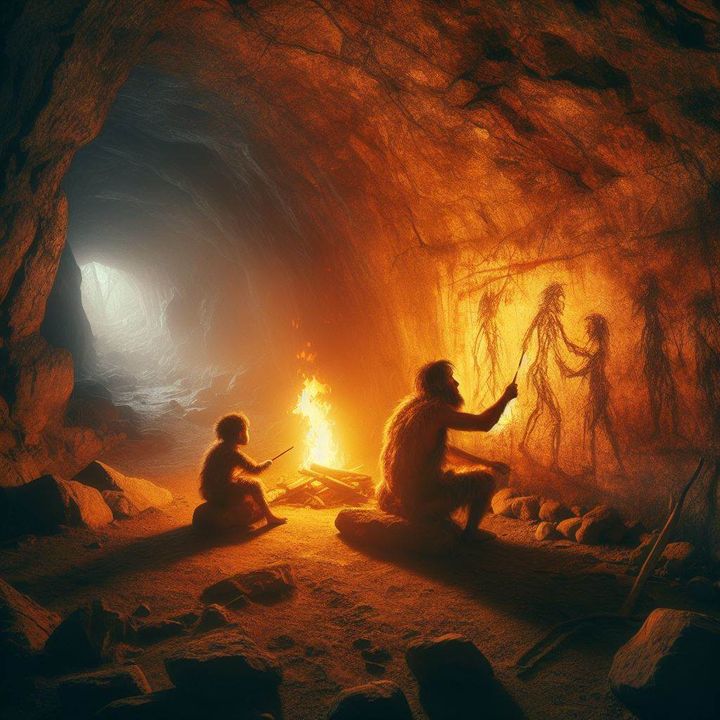
Why prehistory is fascinating me so much
This is a programming blog, so I shouldn't be writing about prehistory.
For prehistory, we generally identify the very long period that goes from the appearance of the first human (which here means the homo sapiens), 300.000 years ago, until the invention of writing, which happened some 5000 years ago. From that moment, we could learn about our ancestors by simply reading what they wrote, given that we find a way to translate the text; but what before that? How can we learn about the first sapiens? What was their life? What were their problems?
I am no professor of archeology, and all you'll read in this post is just an enthusiastic write-out of something I am very passionate about. There may be imprecisions, wrong dates, no references, so don't send this article to anyone to prove your point :)
Some cool facts about Sapiens
There are a few facts about first Sapiens that are incredibily interesting. Most of what we know is due to archeological findings, which allowed us to set dates and proove hipotesis.
- The very first Sapiens (which is the specie of you reading this) came out around 300.000 years ago.
- When the Sapiens came out, they were not alone. We are thought at school that it's like "first Herectus then Habilis then Neanderthal then Sapiens" while in practice it is waaay more complicated. When the Sapiens made their appearence in this world, other humans were around, and they were "similar", but not equal. Sapiens, for a couple of millenia, coexisted with Nehandertals and the lesser known Denisovans people. Imagine walking around and see other animals that look like you, but they are not like you - different set of genes, reproduction between species is impossible (well... not really), different set of dietary, habits... More like wolves and dogs.
- Evidences show that Sapiens and Neanderthals didn't get along very well. There are many mass graves of Neanderthals, and the fractures found on bones seem to suggest that they died after a tough encounter, perhaps to defend their territory.
- Some archeologists suggest that the ability to cooperate and to imagine non-existent things is what gave us the competitive advantage against other species. Think about paintings on caves, gathering all together around fires, talk about legends... before Sapiens, no animal could do that.
- Strangely enough, today's Sapiens DNA is composed by a significant part of nehandertal's DNA, which makes all of this even more weird. Our ancestors liked to interbreed.
- The very first Sapiens were hunters-gatherers. They probably hunted a lot - this explains the extintion of big animals exactly when Sapiens arrived in their area - but they also moved around to gather fruits, vegetables and radixes directly from the woods. Some archeologists estimate that this task would require 4 hours per day on average, which means the rest of the day the Sapiens could enjoy some free time (yeah, let's paint the cave!).
- Invention of agriculture was probably what fucked us up. We were nomads, had to move a lot to gather food, and in a couple of generations we became slaves of agriculture, which required more effort, changed our diet drastically, and made us become sedentiary.
The Indo-Europeans
There's another great group that caught my interest recently, and those are the Indo-Europeans. Basically, these guys around 3000 b.C. (so, 5000 years ago) started to spread out from modern Ukraine/Russia to Europe and India. We know about them because of their biggest lefting: their language. Archeological proofs seem to point to a group of people now called Yamnaya.
A century ago some linguists noted that many languages shared too many words in common: how sanscrit can be related to, say, latin? This made some scientists study the problem and it turns out it was a great attack surface for the problem. The cool fact is, the theory proved out to be true, thanks to archeological findings.
- When archeologists find a new text, the first thing they try to do is to compare it with other known texts, and see if they share same words from other languages. Incredibly, a huge number of languages seem to descend from this proto-indo-european language. An example is the world "father", which has a very similar sound in different languages: padre, pater, pita, pedar... or the numer two: due, duo dva, twai, do, etc.
- The language is a reflection of what exists around the people who spoke that language. In almost every indo-european descendant there's the world "equs", that stands for "horse", but the word for "salmon" is only present in some nordic languages, meaning that probably the very first speakers lived in the mainland and not on the sea. Based on these deductions we understood that very first speakers had familiarity with horse and sheep breeding.
Following this pattern and comparing languages, we could figure out how groups of people migrated, by checking what sub-languages had in common and what not. - Before the indo-europeans "invasion", there were at least other 3 groups of humans in Europe, however they seem to have been aximilated by the yamnayas, maybe with wars, maybe gradually and softly, however it's incredible how proto-indoeuropean became predominant almost instantly and everywhere.
Some references
- Sapiens, by Yuval Noah Harari - a great introduction to the subject. I remember that, while reading it, I was thinking: I've never thought of the history of humankind this way. It gave me a lot to think.
- L'invasione (The invasion), an italian podcast on the proto-indoeuropeans. Only in Italian, unfortunately.
